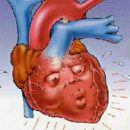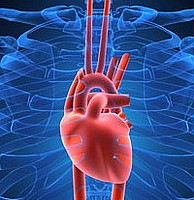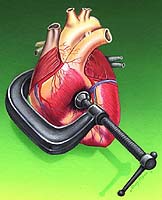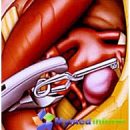What is the patch of the heart with an open arterial protocol, a defect of the interpresentation partition, a defect of the interventricular partition, which operations are necessary and what results should be expected? Read in this article.
Content
The doctor may establish that the heart surgery is needed to treat your child with an UPU. In this case, it is advisable for you to figure out what the heart disease is, what operation is needed and what results should be expected.
Purpose of the operation — Maximum correctly fix heart rate and normalize blood circulation, as far as possible. Some children to achieve maximum effect have to be done not one operation. During operation, abnormally developed parts of the heart or vessels can be corrected in several ways. Some vices cannot be completely eliminated, and help can only be provided in the form of facilitating (palliative) operations that allow you to hold the child's well-being or to win. The following descriptions and drawings of the most frequent heart defects will help you understand the essence of your child's disease.
Open arterial duct (OAP)
Each child is born with an arterial duct. It is a message between the two main blood vessels (trunk arteries) — pulmonary artery and aorta. Pulmonary artery carries venous «blue» blood from the right hearts of the heart to the easy. Aorta carries arterial «Aluu» oxygen-enriched blood from the left sections of the heart.
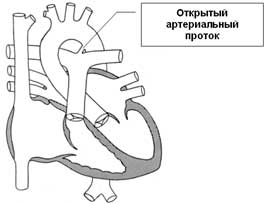 Normally, this duct (OAP) closes a few hours after birth, it is possible to closure a duct independently or a prompt treatment of up to 9 months. If this does not happen, then some of the blood, which should go along the aorta and feed the organs of the body, returns to the lungs. Especially often this vice is found in premature babies, and quite rarely — In children born in time.
Normally, this duct (OAP) closes a few hours after birth, it is possible to closure a duct independently or a prompt treatment of up to 9 months. If this does not happen, then some of the blood, which should go along the aorta and feed the organs of the body, returns to the lungs. Especially often this vice is found in premature babies, and quite rarely — In children born in time.
If the OAP is great, the child quickly gets tired, slowly grows, is susceptible to the diseases of pneumonia and breathes rapidly. In some cases, symptoms may not be detected during the first weeks or months of life. If the oak is small, the child does not seem healthy in general.
As a result of the existence of duct, the lungs are overloaded with blood, which over time leads to serious changes in the vessels of the lungs. He also suffers from the heart that works with overload.
Surgical treatment is shown to absolutely all children over 9 months, and it is shown to children up to 9 months with a severe course of the disease and large duct sizes.
The OAP is closed by dressing it, in more rare cases, the intersection of the flow. In the absence of other defects, blood circulation after that comes to normal.
Defect of the Interpidential Partition (DMPP)
Sometimes children are born with a hole in the interpresentation partition.
 When there is a wide message between atria, a large number of arterial «Alooy» blood from the left half of the heart is reset into the right where the blood is venous «blue». All this amount of blood flows through the right heads of the heart and causes significant overload of their (right atrium and right ventricle).
When there is a wide message between atria, a large number of arterial «Alooy» blood from the left half of the heart is reset into the right where the blood is venous «blue». All this amount of blood flows through the right heads of the heart and causes significant overload of their (right atrium and right ventricle).
This process continues continuously and over time to lead to serious violations in the work of the heart. Most children do not have any noticeable symptoms in early childhood.
Surgical treatment Closure in childhood defect of the interdestrian partition under the conditions of artificial blood circulation (sometimes with a patch call) will prevent serious complications. And not only this, long-term life prospects also become very good.
Defect of the interventricular partition (DMWP)
With the presence of a large hole between the ventricles, a large number of arterial blood from the left heap departments is reset through it in the right. Then blood is pumped again into the lungs. Such a blood circulation in which the blood already visited in the lungs returns there again is ineffective. The heart that needs to pump additional blood is overloaded and increased in size.
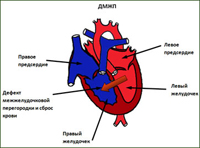 Symptoms usually appear in a few weeks after birth. Some children with large DMWP are lagging behind in physical development and have reduced weight. In the lung vessels due to the large number of blood flowing pressure can be elevated. Some time later, high pressure may cause persistent damage to the vessels of the lungs. Therefore, as an earlier operation is often needed.
Symptoms usually appear in a few weeks after birth. Some children with large DMWP are lagging behind in physical development and have reduced weight. In the lung vessels due to the large number of blood flowing pressure can be elevated. Some time later, high pressure may cause persistent damage to the vessels of the lungs. Therefore, as an earlier operation is often needed.
If a hole is not enough, the heart does not experience big overload. In this case, the only sign pointing to the disease is a loud noise detected while listening to the heart. Operation in this case may not be needed, the hole will gradually close itself.
Children with an average defect defect elimination of vice can be postponed.
Surgical treatment - the closure of a partition defect is made with artificial blood circulation.Very often the hole is so great that you have to put the pay in order to close it completely. Later paid «overgrown», is covered with normal tissues and becomes part of the heart. But some defects can be closed and without a patch.
If the child feels very bad even in early childhood, only the operation can alleviate his suffering and eliminate increased blood pressure in the vessels of the lungs. Using the escape operation of the pulmonary artery (Muller operation) decreases the lumen of the pulmonary artery (LA), and the blood flow in the lungs is reduced. This palliative (facilitating) procedure allows the child to develop normally. When the child is growing, doctors will be able to remove the braid, narrowing la, and perform an operation on the open heart.


